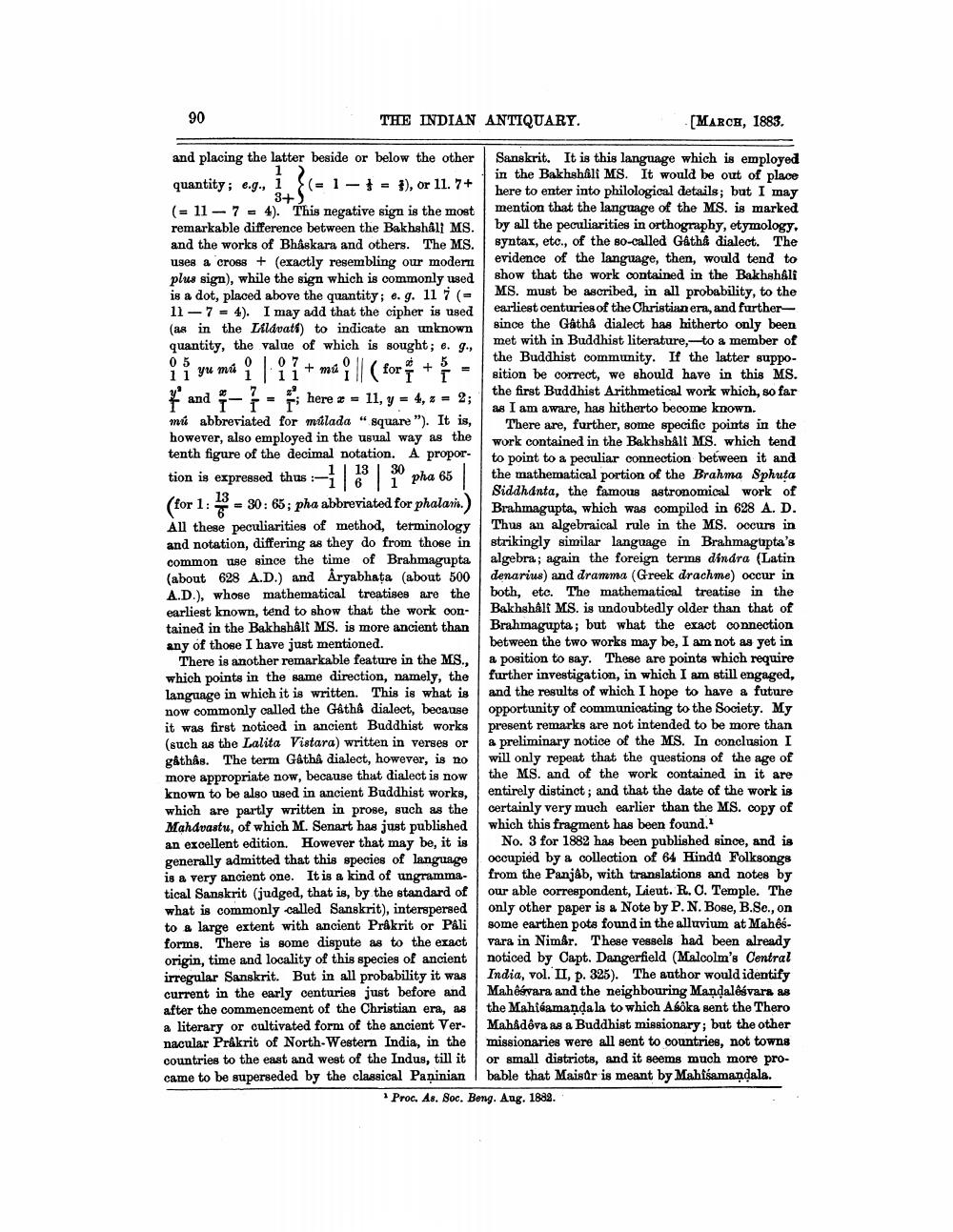________________
90
THE INDIAN ANTIQUARY.
[MARCH, 1883.
and placing the latter beside or below the other Sanskrit. It is this language which is employed
in the Bakhshält MS. It would be out of place quantity; e.g., i. (= 1 - = ), or 11. 7+
here to enter into philological details; but I may (= 11 - 7 = 4). This negative sign is the most mention that the language of the MS. is marked remarkable difference between the Bakhshâli MS.
by all the peculiarities in orthography, etymology, and the works of Bhaskara and others. The MS. syntax, etc., of the so-called Gåthå dialect. The uses a cross + exactly resembling our modern
evidence of the language, then, would tend to plus sign), while the sign which is commonly used
show that the work contained in the Bakhshali is a dot, placed above the quantity; e. g. 11 7 (
MS. must be ascribed, in all probability, to the 11-7 - 4). I may add that the cipher is used
earliest centuries of the Christianera, and further (as in the Lildvats) to indicate an unknown
since the Gâthå dialect has hitherto only been quantity, the value of which is sought; 6. g.,
met with in Buddhist literature, -to a member of
the Buddhist community. If the latter suppoi yu mú i | i?+ mai || (for + sition be correct, we should have in this Ms. * and 7- 1 - 'here z = 11, y = 4,2 = 2;
the first Buddhist Arithmetical work which, so far
as I am aware, has hitherto become known. mít abbreviated for mülada "square"). It is,
There are, further, some specific points in the however, also employed in the usual way as the
work contained in the BakhshAli MS, which tend tenth figure of the decimal notation. A propor
to point to a peculiar connection between it and tion is expressed thus : - 1 2 10 pha 65 the mathematical portion of the Brahma Sphuta
Siddhanta, the famous astronomical work of (for 1: 1 - 30: 65; pha abbreviated for phalan.) Brahmagupta, which was compiled in 628 A. D. All these peculiarities of method, terminology Thus an algebraical rule in the MS. occurs in and notation, differing as they do from those in strikingly similar language in Brahmagupta's common use since the time of Brahmagupta algebra; again the foreign terms dindra (Latin (about 628 A.D.) and Aryabhata (about 500 denarius) and dramema (Greek drachme) occur in A.D.), whose mathematical treatises are the both, etc. The mathematical treatise in the earliest known, tend to show that the work oon- Bakhshalt MS. is undoubtedly older than that of tained in the Bakhshalt MS. is more ancient than Brahmagupta; but what the exact connection any of those I have just mentioned.
between the two works may be, I am not as yet in There is another remarkable feature in the MS., a position to say. These are points which require which points in the same direction, namely, the further investigation, in which I am still engaged, language in which it is written. This is what is and the results of which I hope to have a future now commonly called the Gatha dialect, because opportunity of communicating to the Society. My it was first noticed in ancient Buddhist works present remarks are not intended to be more than (such as the Lalita Vistara) written in verses or a preliminary notice of the MS. In conclusion I gåthâs. The term Gathêu dialect, however, is no will only repeat that the questions of the age of more appropriate now, because that dialect is now the MS. and of the work contained in it are known to be also used in ancient Buddhist works, entirely distinct; and that the date of the work is which are partly written in prose, such as the certainly very much earlier than the MS. copy of Mahdvastu, of which M. Senart has just published which this fragment has been found. an excellent edition. However that may be, it is No. 3 for 1882 has been published since, and is generally admitted that this species of language occupied by a collection of 64 Hindd Folksongs is a very ancient one. It is a kind of ungramma- from the Panjab, with translations and notes by tical Sanskrit (judged, that is, by the standard of our able correspondent, Lieut. R. O. Temple. The what is commonly called Sanskrit), interspersed only other paper is a Note by P. N. Bose, B.Sc., on to a large extent with ancient Prakrit or Pali some earthen pots found in the alluvium at Mahesforms. There is some dispute as to the exact vara in Nimêr. These vessels had been already origin, time and locality of this species of ancient noticed by Capt. Dangerfield (Malcolm's Central irregular Sanskrit. But in all probability it was India, vol. II, p. 325). The author would identify current in the early centuries just before and Mahesvara and the neighbouring Mandalesvars as after the commencement of the Christian era, as the Mahićamanda la to which Asöka sent the Thero a literary or cultivated form of the ancient Ver- Mahadôva as a Buddhist missionary; but the other nacular Prakrit of North-Western India, in the missionaries were all sent to countries, not towns countries to the east and west of the Indus, till it or small districts, and it seems much more procame to be superseded by the classical Paninian l bable that Maisar is meant by Mahfśamandala.
Proc. As. Soc. Beng. Ang. 1882.




